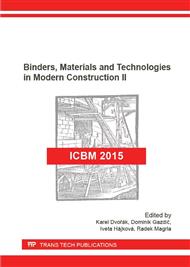[1]
M. Zielecka, E Bujnowska: Silicone-containing polymer matrices as protective coatings: Properties and applications. Prog. Org. Coat., 55(2), (2006), pp.160-167.
DOI: 10.1016/j.porgcoat.2005.09.012
Google Scholar
[1]
D. Stoye, W. Freitag, G. Beuschel (Eds. ): Resins for coatings: chemistry, properties, and applications, HanserVerlag (1996).
Google Scholar
[2]
M. Wesołowska, K. Pawełkowski, M. Kempiński, M. Kaczmarek: Compatibility of masonry components from gas permeability tests. 8th International Masonry Society, Masonry 11, Proc. 8th International Masonry Conference; Dresden (2010), pp.465-474.
DOI: 10.1201/b21889-71
Google Scholar
[3]
W. Brachaczek: The modelling technology of protective silicone coatings in terms of selected physical properties: hydrophobicity, scrub resistance and water vapour diffusion. Prog. Org. Coat. 77 (2014), pp.859-867.
DOI: 10.1016/j.porgcoat.2014.01.016
Google Scholar
[4]
M. Wesołowska, K. Pawłowski, A. Kaczmarek, K. Kończal: Exploitation problems of single layer walls of autoclave cellular concrete. 5th International Conference on Autoclaved Aerated Concrete Securing a sustainable future, Bydgoszcz (2011).
Google Scholar
[5]
W. Brachaczek, The hydrophobicity of renovation plaster in manufacturing technology optimized by statistical methods, Constr. Build. Mater. 49 (2013) pp.575-585.
DOI: 10.1016/j.conbuildmat.2013.08.051
Google Scholar
[6]
T. Easton, S. Poultney: Waterborne silicone-organic hybrid coatings for exterior applications, J. Coat. Technol. Res., 4 (2) (2007) p.187–190.
DOI: 10.1007/s11998-007-9018-z
Google Scholar
[7]
M. Andriotet. al. Chapter 2 - Silicones in Industrial Applications, Inorganic Polymers, Nova Science Publishers, pp.61-161, (2007).
Google Scholar
[8]
J. Juraszek, A. Grzywa: Stress and strain analysis with use of the FBG method. CBIDGP, (2013), pp.220-230.
Google Scholar
[9]
J. Juraszek: Monitoring of structures in civil engineering, Logistics (2014), pp.4956-4965.
Google Scholar
[10]
W. Heilen, Silicone resins and their combinations, Hannover: Vincentz Network, (2005).
Google Scholar
[11]
EN ISO 7783: 2011 Paints and varnishes. Determination of water-vapour transmission properties. Cup method.
DOI: 10.3403/30189226
Google Scholar
[12]
S.A. Glanz, B. K. Linker, Primer of Applied Regression and Analysis of Variance, McGraw-Hill, New York, (2001).
Google Scholar
[13]
L. Falchi, et al.: Statistical analysis of the physical properties and durability of water-repellent mortars made with limestone cement, natural hydraulic lime and pozzolana-lime. Construction and Building Materials 78 (2015): 260-270.
DOI: 10.1016/j.conbuildmat.2014.12.109
Google Scholar
[14]
WTA – Merkblatt 2-9-04/D Sanierputzsysteme, Renovation mortar systems, deutsche Fassungvom 24. 10. (2005).
Google Scholar
[15]
EN 1062-1: 2005 Paints and varnishes. Coating materials and coating systems for exterior masonry and concrete. Part 1: Classification.
DOI: 10.3403/01018947u
Google Scholar


